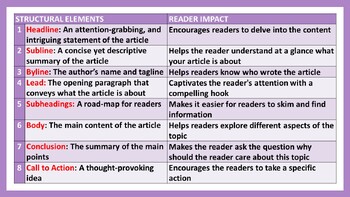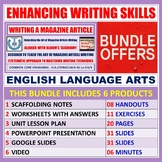Unlocking the Art of Magazine Article Writing - Google Slides
JOHN DSOUZA
1.1k Followers
Grade Levels
9th - 12th
Subjects
Resource Type
Standards
CCSSW.9-10.1
CCSSW.9-10.1a
CCSSW.9-10.1b
CCSSW.9-10.1c
CCSSW.9-10.1d
Formats Included
- Google Slides™
- Internet Activities
Pages
31 pages
JOHN DSOUZA
1.1k Followers

Made for Google Drive™
This resource can be used by students on Google Drive or Google Classroom. To access this resource, you’ll need to allow TPT to add it to your Google Drive. See our FAQ and Privacy Policy for more information.
Also included in
- "Unlocking the Art of Magazine Article Writing," is the ultimate resource bundle designed to equip students with the skills and knowledge to excel in crafting engaging and impactful magazine articles. This video course follows Bloom's Taxonomy and aligns with the Common Core Standards for ELA-LiteraPrice $11.90Original Price $17.00Save $5.10
Description
"Unlocking the Art of Magazine Article Writing" is the ultimate Google Slides designed to equip students with the skills and knowledge to excel in crafting engaging and impactful magazine articles. This resource follows Bloom's Taxonomy and aligns with the Common Core Standards for ELA-Literacy in Writing. It provides a step-by-step approach to becoming a proficient magazine article writer, covering various key aspects.
This resource includes:
REMEMBERING
- Recall key elements of magazine article structure and style.
- Identify the basic components of a magazine article (headline, subline, byline, lead, body and conclusion).
- List the characteristics that distinguish a magazine article from other forms of writing.
- Recall and define relevant vocabulary associated with magazine article writing.
- Match the structural elements with their meaning.
UNDERSTANDING
- Demonstrate an understanding of the purpose and audience considerations in magazine article writing.
- Explain the primary purpose of a magazine article.
- Identify the target audience for a given magazine article.
- Describe how the tone and style of writing may vary based on the intended readership.
- Match the language features (DAFORSTI) with their impact on the readers.
- Select the best option that answers each of the questions to demonstrate your understanding of the magazine article.
APPLYING
- Apply knowledge of magazine article elements to create well-structured and engaging articles.
- Develop a magazine article outline incorporating key components (headline, subline, lead, body and conclusion).
- Apply appropriate language and tone to convey the intended message to the target audience.
- Incorporate relevant quotes or anecdotes to enhance the content of the magazine article.
- Select relevant material from the given passage and plan a magazine article using the planning frame.
- Use the sample plan to write the first draft of a magazine article.
- Use the sentence frame to write the final draft of a magazine article.
ANALYSING
- Analyse magazine articles to identify effective and ineffective writing techniques.
- Critique the structure of a magazine article, highlighting strengths and weaknesses.
- Identify the use of persuasive elements and rhetorical devices in a magazine article.
- Analyse the impact of structural elements on the overall effectiveness of a magazine article.
- Analyse the magazine article and identify the structural elements and their impact on the reader.
EVALUATING
- Assess the quality and effectiveness of one's and peers' magazine articles.
- Evaluate the clarity and coherence of your magazine article about the intended purpose.
- Provide constructive feedback to peers on the strength of their arguments and use of evidence.
- Assess the overall impact of the language features of the magazine on the target audience.
- Evaluate the magazine article for the author’s use of language.
CREATING
- Produce original and compelling magazine articles that demonstrate creativity and critical thinking.
- Develop a unique and attention-grabbing headline and subline for the magazine article.
- Create a lead that captivates the reader's interest and provides a clear sense of the article's focus.
- Craft a conclusion that leaves a lasting impression on the reader and effectively wraps up the article.
- Differentiated tasks categorised into below-average, average, above-average and very high.
More reading and writing resources by the same author:
- Descriptive Writing
- Narrative Writing
- Persuasive Writing
- Argumentative Writing
- Newspaper Report
- Biography
- Information Text
- Diary Entry
- Magazine Article
This is what teachers say about these resources:
- PREPOSITIONS OF PLACE: 27 GOOGLE SLIDES - comment from A Social Teacher: "My students found the slides very engaging." Rating: 5/5 (extremely satisfied)
- SENTENCE KINDS BY FUNCTION: 24 GOOGLE SLIDES - Denise Hickey: "This is a great resource that is easy to use." Rating: 4/5 (very satisfied).
- IDIOMS: GOOGLE SLIDES - BASED ON BLOOM'S TAXONOMY - Marie Seaman: "Super resource!" Rating: 5/5 (extremely satisfied)
- IF- BY RUDYARD KIPLING - READING A DIDACTIC POEM - GOOGLE SLIDES - Comment from Aaron Nicholson: "This resource assisted me in teaching my scholars not just about didactic poetry but enhanced my instruction on how to analyze this particular poem." Rating: 5/5 (extremely satisfied)
Customer Tips: How to get TPT credit to use for future purchases
- Follow me HERE to get notified of updates, sales, free resources, and new products.
- Please go to your My Purchases page (you may need to LOG IN). Beside each purchase, you'll see a Provide Feedback button. Simply click it, and you will be taken to a page where you can give a quick rating and leave a short comment about the product.
- Each time you give feedback, TPT gives you feedback credits that you can use to lower the cost of your future purchases.
- I value your feedback greatly, as it helps me determine which products are most valuable for your classroom so I can create more for you.
- Look for the green star next to my store logo and click it to become a FOLLOWER. You will now receive email updates about this store. Be the first to know about my new discounts, freebies, and product launches.
Find Me Here:
- TPT Store - JOHN DSOUZA
- Pinterest - JOHN DSOUZA
- Facebook - TOMORROW’S CLASSROOM TODAY
- Instagram - JOHN421969
- Twitter - JOHN421969
- Boom Learning - JOHN DSOUZA
- YouTube - JOHN DSOUZA
Total Pages
31 pages
Answer Key
Included with rubric
Teaching Duration
1 hour
Report this resource to TPT
Reported resources will be reviewed by our team. Report this resource to let us know if this resource violates TPT’s content guidelines.
Standards
to see state-specific standards (only available in the US).
CCSSW.9-10.1
Write arguments to support claims in an analysis of substantive topics or texts, using valid reasoning and relevant and sufficient evidence.
CCSSW.9-10.1a
Introduce precise claim(s), distinguish the claim(s) from alternate or opposing claims, and create an organization that establishes clear relationships among claim(s), counterclaims, reasons, and evidence.
CCSSW.9-10.1b
Develop claim(s) and counterclaims fairly, supplying evidence for each while pointing out the strengths and limitations of both in a manner that anticipates the audience’s knowledge level and concerns.
CCSSW.9-10.1c
Use words, phrases, and clauses to link the major sections of the text, create cohesion, and clarify the relationships between claim(s) and reasons, between reasons and evidence, and between claim(s) and counterclaims.
CCSSW.9-10.1d
Establish and maintain a formal style and objective tone while attending to the norms and conventions of the discipline in which they are writing.






